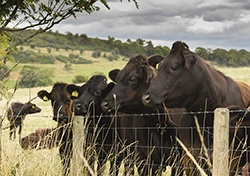
Farming is not for the weak-willed. It takes a strong mind, a strong body, and a strong wallet too. We put a lot of sweat and money into buying, raising, and caring for our livestock. We need to put the same level of effort into protecting our investment. Here is a collection of tips to ensure your livestock fence is the strongest it can be.
- Plan. Plan. Before you buy a thing, do your research. There are a tremendous amount of resources available to farmers on fencing styles, materials and planning. You need to have a plan so complete that you could hand it to a stranger and they could build it. You need all of your measurements, materials, and installation plans laid out. Research depths and distances for pole placement, best materials based on your livestock type, and best practices for installation and maintenance.
- A fence is only as good as its corners. The backbone of your fencing system needs to be stable. Brace posts need to be strong and lasting. Treated wood is the best material. Base the size of the post on how much fence you’re installing. A taught fence will be pulling all those posts towards the center so they need to be substantial. The larger the diameter, the stronger the post. For example, a 4" post has twice the strength of a 3" post, while a 5" post has four times the strength of a 3" post. They should be set a minimum of 3.5’ into the ground. Add cement for stability.
- Mind your line spacing. Consider what the goal of your fence is. Is it to keep cattle in? Or chickens? Does it need to keep predators out? Is it electrified or barbed? All of these factors will affect the spacing of your line posts. If you space them too far, they’ll be no match for your bigger livestock. The average spacing distance is 8-12’, and they should be set 2-2.5’ deep.
- Choose the best wire. This may also mean the more expensive wire, but when it comes to wire quality, you can pay for it now or you can pay for it later. Wire acts as a visual and physical barrier and you need to plan for it to act as both. There are three types of wire traditionally used in livestock fencing: barbed, woven or high-tensile smooth. High-tensile smooth wire, for an electric fence, tends to be the most economical, costing 25-75 percent less than its counterparts and lasting up to 20 years if maintained properly.
- Use the right fasteners. If you’ve taken time to install your posts correctly, and chosen a high-quality wire, don’t throw it all away by being cheap with your fasteners. Generally, if you are using softer posts or posts with thick bark on them, use a longer staple. Harder woods require a shorter staple to do the same job. When driving fence staples, drive them at a slight angle to the vertical axis of the post. This keeps both points of the staple from sinking into the same vertical grain of the wood and possibly splitting it. The BECK Fence Stapling System is the perfect balance of superior holding strength and superior corrosion resistance.
Your livestock fence protects your investment and your livelihood, so take great care in planning, installing, and maintaining it. A well-built fence will save you costly headaches in the future. And with the added benefit of using a pneumatic stapler for ease and speed, we ensure your large wire fencing jobs are done with both the quality you need and the efficiency you require.
.svg.png)

